Max Mercury Joins Jupiter in Morning, Late-rising Luna, and Some Dog Treats!
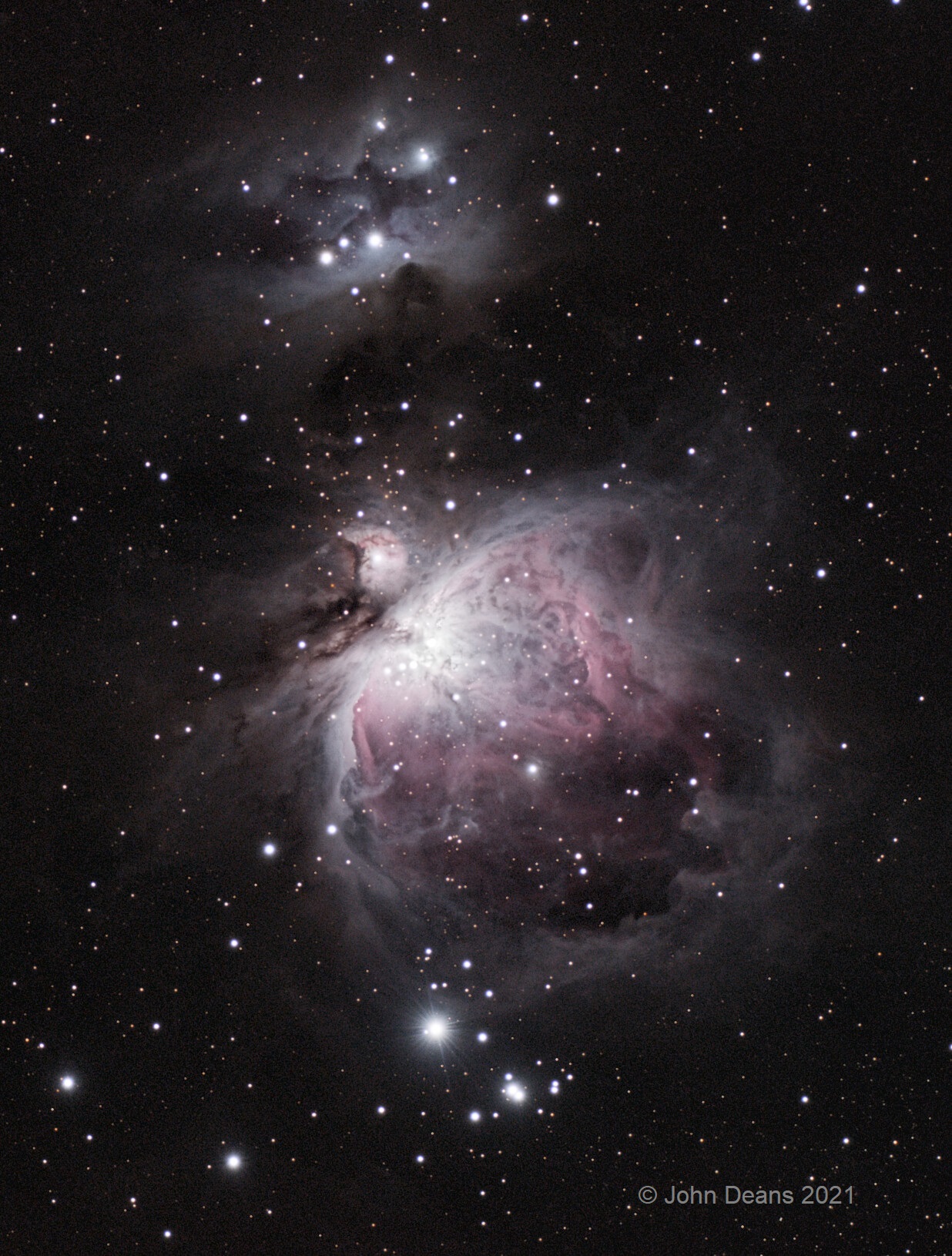
This image of Orion’s Sword by my friend John Deans includes the Great Nebula in Orion, also known as Messier 42 and Messier 43, at centre. The bright knot of stars in the centre of the nebula were born out of the gas around them and are illuminating the nebula. The patch of nebulosity at the top is called the Running Man. It was taken in very dark skies near Bancroft, Ontario through a Nikon D5300 camera attached to a Sky-Watcher EvoStar 72mm telescope, all piggy-backed on a Celestron 8SE mount. To the unaided eye, the sword shows three patches of light.
Hello, March Stargazers!
Here are your Astronomy Skylights for the week of February 28th, 2021 by Chris Vaughan. Feel free to pass this along to your friends and send me your comments, questions, and suggested topics. You can also follow me on Twitter as @astrogeoguy! Unless otherwise noted, all times are expressed in Eastern Time. To subscribe to these emails please click this MailChimp link.
I can bring my Digital Starlab portable inflatable planetarium to your school or other daytime or evening event, or teach a session online. Contact me through AstroGeo.ca, and we’ll tour the Universe, or the Earth’s interior, together!
The moon will wane in phase and leave the evening sky nice and dark for observers around the world this week – allowing us to explore the wonders of Orion’s faithful companion Canis Major. Meanwhile, Mars will approach its mirror image Aldebaran in Taurus, and swing closely past the Pleiades – while Uranus sits below them in Aries. The rest of the visible planets are tucked close to the sun in the pre-dawn, where fast Mercury will play tag with Jupiter and reach peak visibility at week’s end. Read on for your Skylights!
Zodiacal Light
If you live in a location where the sky is free of light pollution, you might be able to spot the Zodiacal Light, which will appear during the two weeks that precede the new moon on Saturday, March 13. After the evening twilight has disappeared, you’ll have about half an hour to check the western sky for a broad wedge of faint light extending upwards from the horizon and centered on the ecliptic (i.e., below Mars). That glow is the zodiacal light – sunlight scattered from countless small particles of material that populate the plane of our solar system. Don’t confuse it with the brighter Milky Way, which extends upwards from the northwestern evening horizon at this time of year.
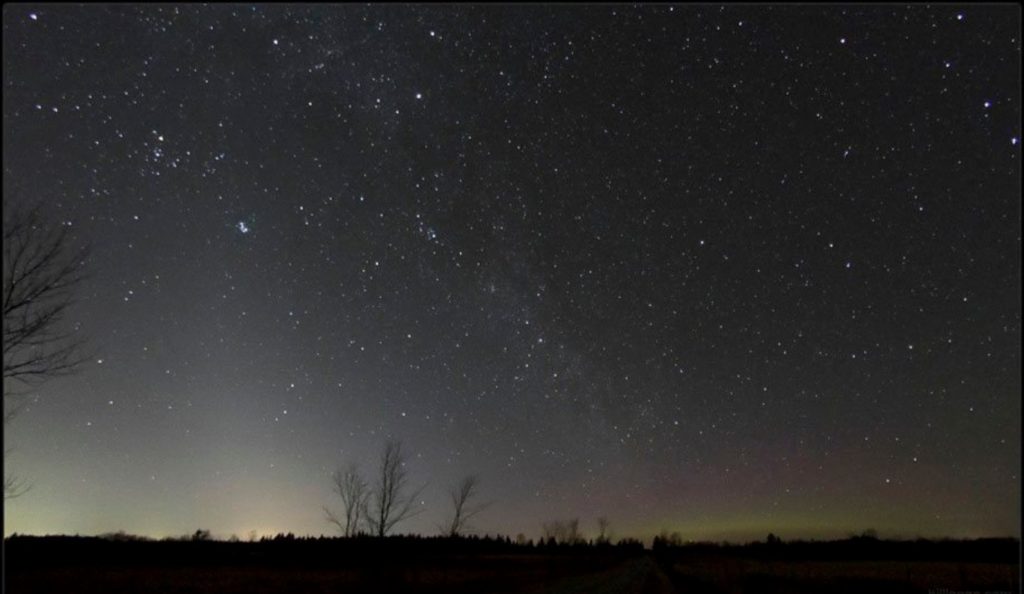
The Moon
For the first several nights of this week, the moon will shine brightly in the late evening and overnight sky all around the world. But our waning next-door neighbour will also be swinging towards the pre-dawn sun, causing the moon to rise about 70 minutes later each night. And that means dark evening skies for star lovers!
Tonight (Sunday) the still-very-full moon will rise at about 8 pm in your local time zone. It won’t climb higher than the trees and houses for a couple of hours, giving us time to use our binoculars and telescopes on the stars for a while. That viewing window will increase on each consecutive night this week.
The moon will spend Sunday to Tuesday traversing the stars of the lengthy constellation of Virgo (the Maiden). She spans 53° of the sky (out of the 180° that stretch from horizon to horizon)! On Wednesday night the waning gibbous moon will rise among the stars of Libra (the Scales) at about midnight local time – and then linger to shine in the southwestern early morning sky. On Friday morning, the moon will rise near the three little white stars that form the claws of Scorpius (the Scorpion). The bright reddish star Antares, the “rival of Mars” will appear a palm’s width below (or 6° to the celestial south) of the moon.
The moon will officially reach its third quarter phase at 8:30 pm EST on Friday (or 1:30 Greenwich Mean Time on Saturday). At third quarter the moon sits at an angle of 90° from the morning sun, causing us to see the moon half-illuminated, on its western side. The term “third quarter” refers to the fact that the moon has completed three-quarters of its monthly trip around Earth – and not to how the moon looks. After third quarter the moon will only be visible in a dark sky between the wee hours and dawn – crossing the stars of Ophiuchus (the Water-Bearer) on Saturday and then Sagittarius (the Archer) on Sunday. Don’t forget to look for the crescent moon shining low in the southwestern daytime sky on those mornings.
The Planets
Mars really resembles the bright star Aldebaran nowadays! The duo are located high in the western sky after dusk – with the bright reddish dot of Mars shining more than a fist’s diameter to the lower right (or 14° to the celestial northwest) of the reddish star. Aldebaran is actually slightly brighter. Over the course of this week, Mars’ eastward orbital motion will carry it higher and closer to Aldebaran. By next Sunday night, they’ll be only 10.5° apart.
Aldebaran is the brightest star in Taurus (the Bull). Look for a “V” of faint stars extending to the lower right from Aldebaran. That’s the Hyades star cluster, one of the closest clusters to our sun. Together they make up the triangular face of the bull. View them in binoculars, and look for even more stars – many of them close-together double stars!
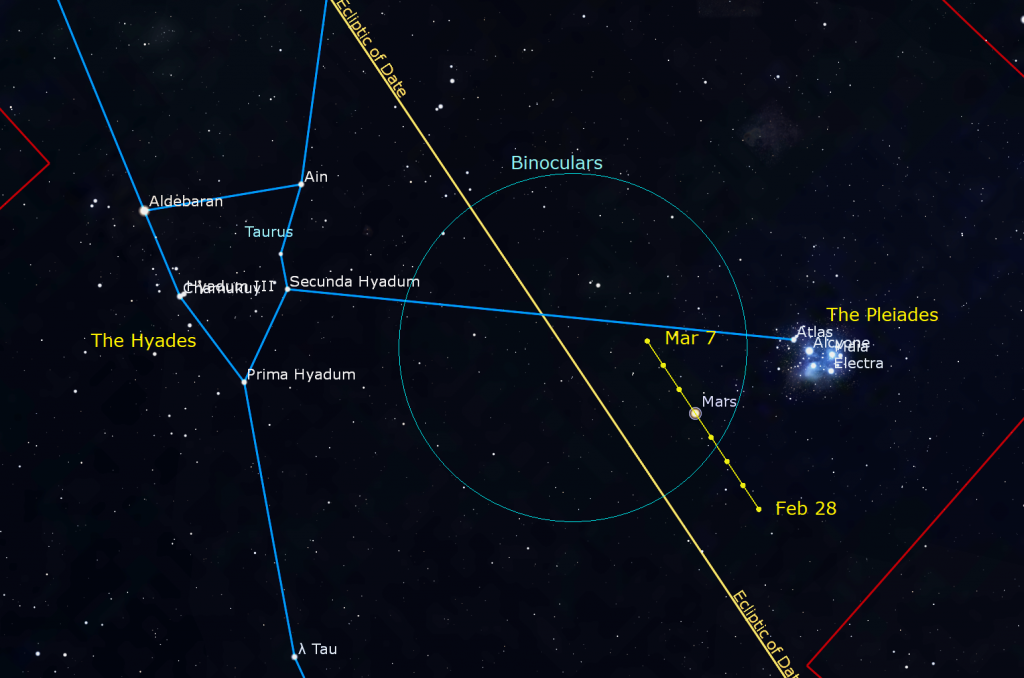
As a bonus this week, Mars will be passing close to the Pleiades star cluster, also known as Messier 45, the Seven Sisters, the Hole in the Sky, and Subaru. The planet and the cluster will be only a few degrees apart from Tuesday to Thursday, with Mars positioned to the left (celestial south) of the Pleiades. They’ll be close enough to easily fit Mars and the Pleiades within the field of view of your binoculars all week long.
The only other planet currently available to view during evening is distant Uranus. The planet can be seen with your unaided eyes on a dark night, and quite easily in binoculars and backyard telescopes. It is located about two fist diameters below (or 20° to the celestial west of) Mars. Try to find the two brightest stars of Aries (the Ram), brighter Hamal and slightly dimmer Sheratan a few finger widths below it. Then search the sky about two fist diameters to their left (celestial south) for the medium-bright star Menkar in Cetus (the Whale). Uranus is a modest, bluish dot parked roughly midway between Sheratan and Menkar. View Uranus early in the evening, when it’s higher in the sky and shining through less of Earth’s distorting atmosphere. In a telescope, Uranus will resemble the stars near it – but the planet won’t twinkle as much as they do, and it will show a blue-green colour.
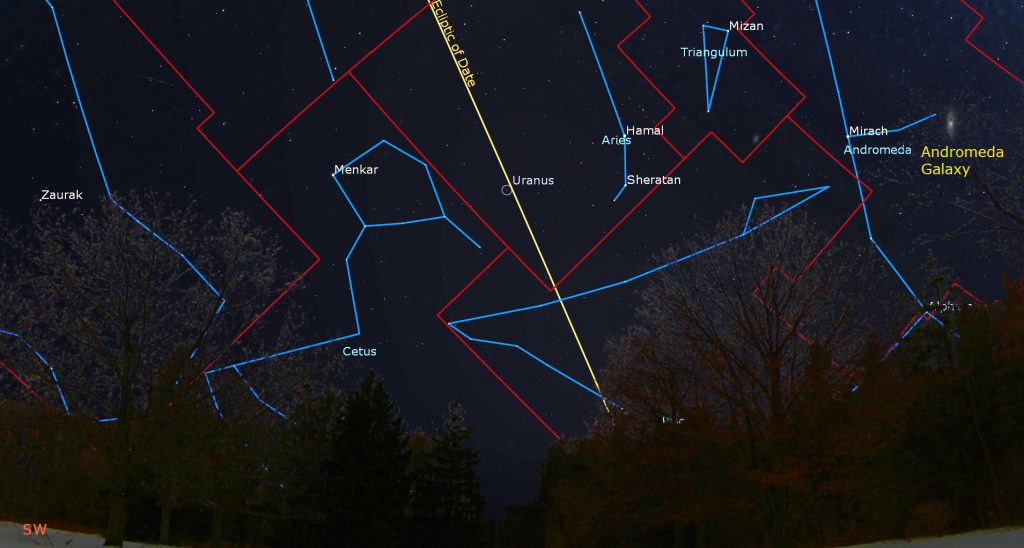
The rest of the bright planets are gathered in the morning pre-dawn – except for Venus which is too close to the sun to be seen. If you have a low and unobstructed view of the east-southeastern horizon, and the morning weather forecast predicts no clouds in that direction, get outside before 6:30 am local time and see how many of the planets you can spot!
Saturn will become visible first – low over the horizon shortly before 6 am local time. About 15 minutes later ten times as bright Jupiter will rise to sit less than a fist’s diameter to the lower left (or 8° to the celestial east). Jupiter will remain visible while fainter Saturn becomes overwhelmed by the brightening sky.
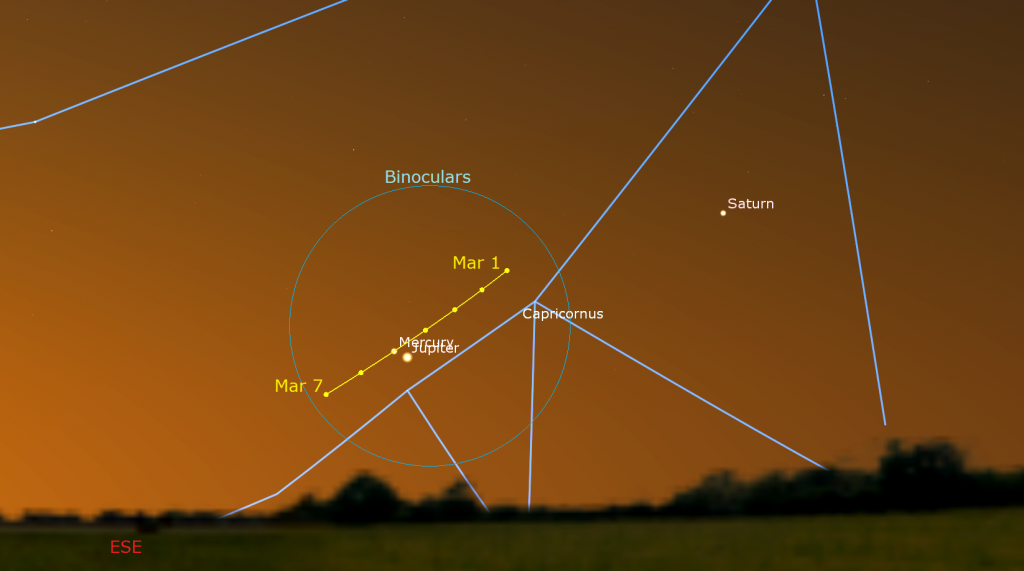
Once you have spotted Jupiter, look for Mercury nearby. The speedy planet will start this week positioned a few finger widths to Jupiter’s upper right (celestial northwest). But each morning will see it descend towards Jupiter. At closest approach on Friday morning, Mercury will be located half a finger’s width to the upper left (or 20 arc-minutes north) of Jupiter, allowing both planets to appear together in the eyepiece of a backyard telescope. The optimal viewing time for observers at mid-northern latitudes will be 5:45 to 6:15 am. Observers at more southerly locations will see the planets in a darker sky. If your skies aren’t clear on Friday, look for Mercury to Jupiter’s lower left (east) on Saturday and Sunday.
Saturday will also mark Mercury’s widest angle of 27° west of the sun, and peak visibility for the current morning apparition. In a telescope Mercury will exhibit a 57%-illuminated, waxing gibbous phase. Mercury’s position south of the shallowly-dipping morning ecliptic is making this a poor apparition for mid-Northern latitude observers, but the best showing of 2021 for those located near the Equator, and farther south.
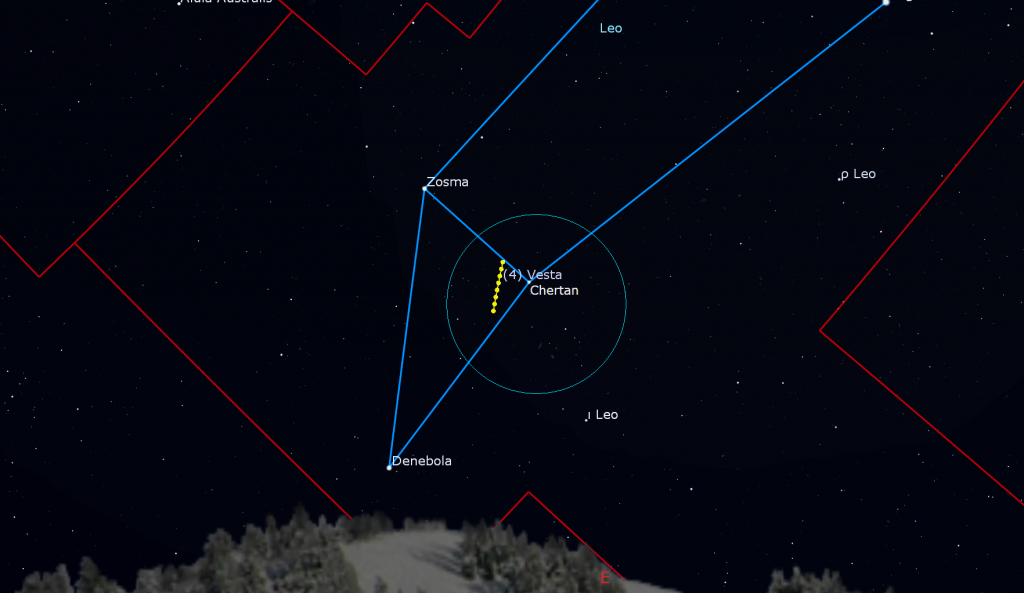
On Thursday night, the Earth’s orbital motion will carry us between the asteroid designated (4) Vesta and the sun. Because it will be opposite the sun in the sky, Vesta will be visible all night long, and shine at its brightest for the year (magnitude 5.8) – well within reach of your unaided eyes from a dark sky location, and in binoculars and small telescopes from the suburbs. Look for the asteroid in the eastern evening sky in Leo (the Lion). Vesta will sit approximately a finger’s width to the lower left (or 1 degree to the northeast) of Chertan, the bright star that marks the lion’s rear haunches. Vesta will travel higher along the left side of Chertan for a number of nights.
Enjoy the Winter Stars
Moonless winter nights are not to be missed. Taurus (the Bull), Auriga (the Charioteer), Orion (the Hunter), and Gemini (the Twins) dominate the southern evening sky. Click the provided links to read my detailed tours of those constellations. I’ll write one for Gemini soon.
In the northern evening sky, the Big Dipper is standing on its handle in the northeast as the Great Bear emerges upwards from her den – and the distinctive “W” of Queen Cassiopeia holds court in the northwest, on the opposite side of Polaris. As the Great Square of Pegasus and Princess Andromeda leave the scene in the west, the majestic Lion, Leo is the harbinger of springtime galaxies in the eastern sky. I hope you’ll take the opportunity to head outside and look up!
Dog Treats
The night sky’s brightest star Sirius is sure to catch your eye in the evening sky this time of the year. Once the sky darkens after 7:30 pm local time, Sirius will be sitting less than a third of the way up the southern sky, to the lower left of Orion (the Hunter). Sirius will reach its highest position over the southern horizon at 8:30 pm and then descend into the southwestern sky and set at about 1:30 am local time.
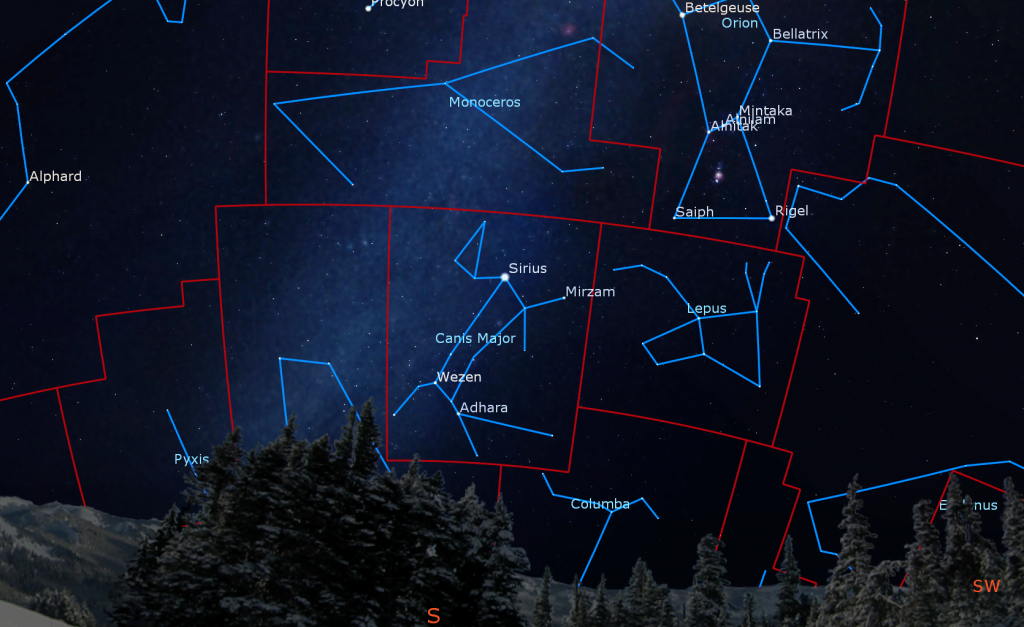
Sirius’ name means “searing” or “scorching” in Greek. It’s also commonly known as the Dog Star because it is the brightest star in the constellation Canis Major (the Big Dog). To my eyes, the constellation genuinely resembles a wiener dog! Sirius sparkles at the dog’s collar. The pup’s head is formed by several medium-bright stars to Sirius’ upper left, but those are near the limit of visibility in urban skies. Nose to tail, the constellation measures about 19°, or two fist diameters; and ears to paws spans about one fist diameter. The rest of the dog’s body, composed of more easily visible stars, extends to the lower left (southeast) of Sirius. The dog is rearing up and facing west, as if he is begging Orion for a treat.
About a fist’s diameter below Sirius is the bright star Wezen, which marks the dog’s “bottom”. Wezen, Arabic for “weight” is a rare, massive, yellow supergiant star. One day it will explode in a supernova. The tip of the dog’s tail, marked by a modest star named Aludra, is found 4° (four finger widths) to the lower left of Wezen. Four degrees to the lower right of Wezen, a bright star named Adhara represents the dog’s rear legs. (Some representations include two dimmer stars for the rear paws.) Adhara is a hot blue giant star with a surface temperature of a whopping 21,000 K and located about 34 light-years from the sun. It’s the brightest star in the sky when viewed in ultraviolet light, and it, too, is on the way to death by supernova.
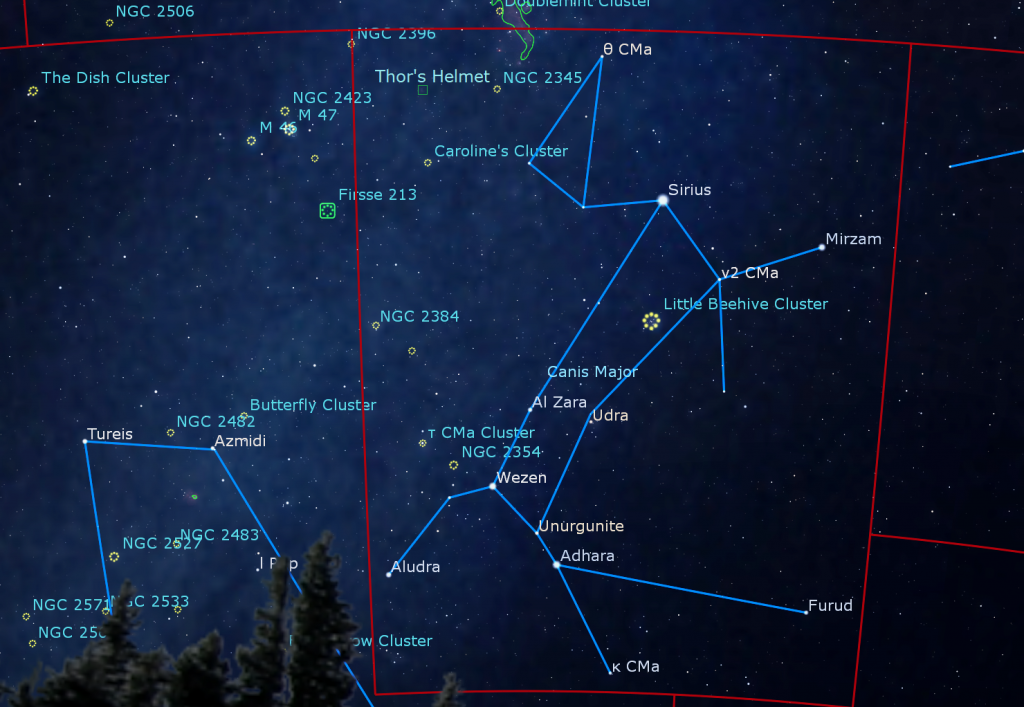
The dog’s front legs are formed by the bright star Mirzam, which is located about a palm’s width to the lower right of Sirius. Mirzam, which means “the Herald” because it rises just before Sirius, is 60 times more luminous than Sirius. If that star were located where Sirius is, instead of 500 light-years away from us, it would appear 15 times brighter than Venus!
In the heart of Canis Major, about four finger widths below Sirius, is a bright little cluster of stars designated Messier 41, sometimes called the Little Beehive Cluster. Binoculars should show it easily. The cluster, which is about 2300 light-years away from us, consists of several brighter golden stars and numerous fainter ones. Another nice cluster sits about 2.5 finger widths to the upper left of Wezen. Scan around that area of sky with your binoculars – the winter Milky Way has populated Canis Major with many such dog treats.

Canis Major is only one of Orion’s two hunting companions. The other, Canis Minor (the Smaller Dog), sits 30° (or three fist diameters) to Orion’s left (east). Canis Minor is composed of only two stars – very bright white Procyon and dimmer Gomeisa, which sits about four finger widths to Procyon’s upper right. Ironically, the constellation resembles a dog bone more than a dog! The two dogs might well be hunting Lepus (the Rabbit), a constellation of modest stars located directly below (south of) Orion.
Sirius is so bright because it is about 25 times more luminous than our Sun, and is only a mere 8.6 light-years away from Earth. Furthermore, it is heading towards us, and will brighten over the next millennia! Sirius has a tiny companion – a white dwarf star designated Sirius B, that some astronomers call the Pup. I prefer to call it the Flea!
Sirius is famous for exhibiting flashes of intense colour as it twinkles. This is because northern hemisphere observers usually see the star positioned low in the sky, so its very bright starlight is passing through a thicker blanket of air. The pockets of turbulence in our atmosphere that makes stars twinkle also work like tiny refracting prisms – splitting apart Sirius’ white starlight and randomly sending different colours (wavelengths) to our eyes.

The ancient Egyptians linked their calendar to the arrival of Sirius in the pre-dawn sky because it signaled the onset of the Nile floods around the beginning of summer. That phenomenon also gave us the expression “Dog Days of Summer”. In China, Sirius is called Tiān Láng天狼, aka “the Celestial Wolf”. Many First Nations cultures saw a dog’s shape in these stars and called Sirius the Moon Dog Star (Inuit), the Wolf Star (Pawnee), and the Coyote Star. On the next clear evening, have a look at our bright neighbour!
Public Astro-Themed Events
Every Monday evening, York University’s Allan I. Carswell Observatory runs an online star party – broadcasting views from four telescopes/cameras, answering viewer questions, and taking requests! Details are here. Their in-person Wednesday night viewing has been converted to online via the observatory YouTube channel, where they offer free online viewing through their rooftop telescopes, including their 1-metre telescope! Details are here.
My free, family-friendly Insider’s Guide to the Galaxy webcasts with Jenna Hinds of RASC National will return on Tuesday afternoon, March 2 at 3:30 pm EST. We’re going to talk about Nebulas, Galaxies, and Star Clusters of the Messier List! You can find more details, and the schedule of future sessions, here and here.
On Wednesday evening, March 3 at 7:30 pm EDT, the RASC Toronto Centre will live stream their monthly Recreational Astronomy Night Meeting at https://www.youtube.com/rasctoronto/live. Talks include the Sky This Month, Nightscape photography, and Tycho Brahe. Details are here.
On Wednesday evening, March 3 at 7 pm, the Perimeter Institute in Waterloo will present The Invisible Universe, a free public talk and webcast about what we currently know about the nature of dark matter and black holes. The speaker is Priyamvada Natarajan, Professor of Astronomy and Physics at Yale University and member of the advisory boards of NOVA ScienceNow, Quanta Magazine, and Scientific American. Registration and details are here.
Our David Dunlap Observatory Saturday night events may be suspended at the moment, but we’re still pleased to offer the next best thing – online talks! On Saturday, March 6 at 7 pm EST, tune in to DDO Astronomy Night: The Life Cycle of Massive Stars with Adaeze Ibik. Adaeze Ibik, a PhD student in the David A. Dunlap Department of Astronomy and Astrophysics at the University of Toronto, will discuss massive stars and supernovae. More information and the registration link can be found here. The modest fee goes to support our ongoing efforts to deliver public programs at DDO.
On Sunday afternoon, March 28 from 1 to 2 pm I’m hosting an online session for RASC called Ask an Astronomer! We’ll explore the night sky together and answer your astronomy and space-related questions in simple language – using pictures, illustrations and planetarium software. The deadline to register is Friday, March 26 at 3:00 pm. Registration is here. A modest fee goes to support our ongoing efforts to deliver public programs at DDO.
Keep looking up, and enjoy the sky when you do. I love questions and requests. Send me some!